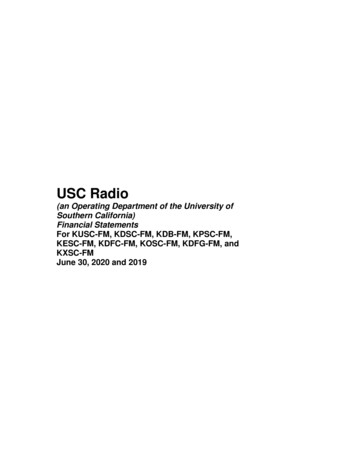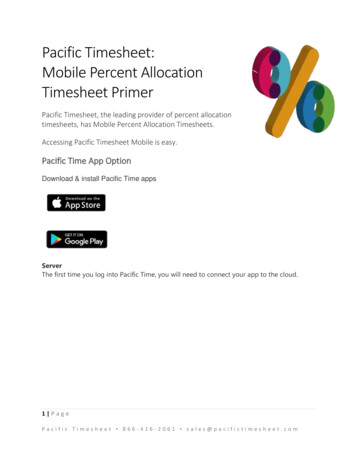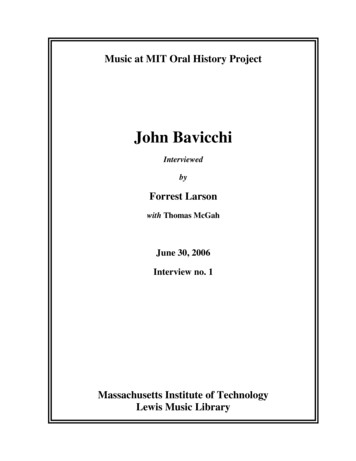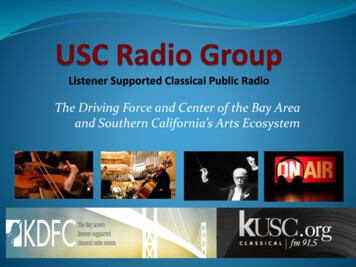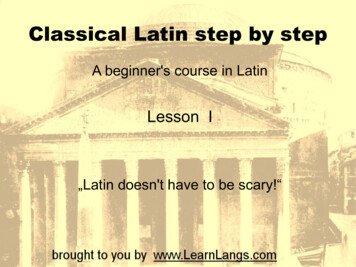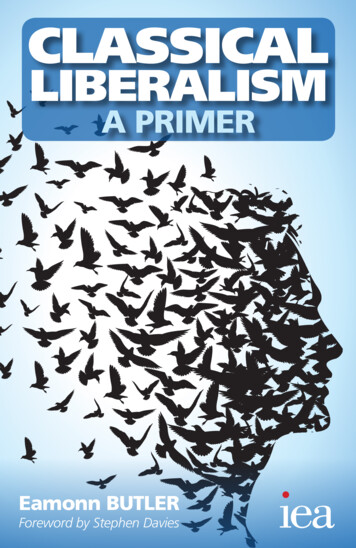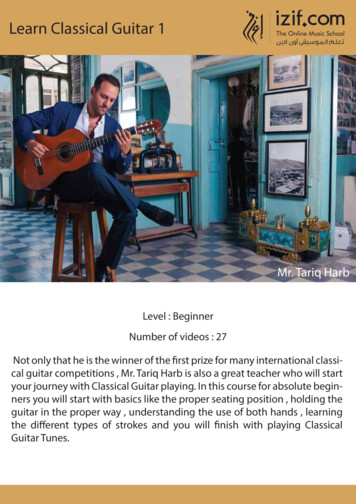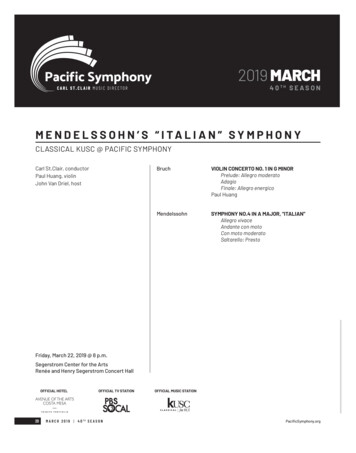
Transcription
2019 MARCH4 0 th s e a s o nM EN D E L SSOHN ’ S “ I TA L I AN ” S Y M P HON YClassical KUSC @ Pacific SymphonyCarl St.Clair, conductorPaul Huang, violinJohn Van Driel, hostBruchVIOLIN CONCERTO NO. 1 IN G MINORPrelude: Allegro moderatoAdagioFinale: Allegro energicoPaul HuangMendelssohnSYMPHONY NO.4 IN A MAJOR, “ITALIAN”Allegro vivaceAndante con motoCon moto moderatoSaltarello: PrestoFriday, March 22, 2019 @ 8 p.m.Segerstrom Center for the ArtsRenée and Henry Segerstrom Concert HallOfficial Hotel20Official TV StationM A R C H 2 0 1 9 4 0 t h S e as o nOfficial Music StationPacificSymphony.org
PROGRAM NOTESLudwig van Beethoven:“Lento assai, cantantee tranquillo” from StringQuartet No. 16There is no musicmore heroic thanBeethoven’s.His symphonies,concertos andopera have an airof monumentalityand reflecthumanity’s noblestaspirations. Buttoward the end ofhis life, Beethoventurned inward,using the intimate scale of the piano sonataand the string quartet to create music thatis equally profound, if less public, than theforms that mobilize the full orchestra. Manyof the composer’s admirers feel that theselate works are his most personal, mostprofound, most transcendent utterances.Beethoven’s String Quartet No. 16 is thelast music he wrote, and its slow, hymn-likelento movement—the longest movement ofthe quartet, full of feeling, yet also serenelyresolute—can be heard as the composer’sfarewell to life on earth. He finished thequartet in October of 1826, about fourmonths before his death. He was aware thathe wouldn’t write another, and appendedthis note with it for his publisher: “Here,my dear friend, is my last quartet. It will bethe last; and indeed it has given me muchtrouble And that is the reason why I havewritten the motto: ‘The difficult decision—Must it be? —It must be, it must be!’”Beethoven was much in Mahler’sthoughts, and in this lento we can hear theprogenitor of Mahler’s symphonic adagios.Like Mahler, Beethoven uses this very slow,reflective pace to contemplate the eternal.In doing so, he leads us to a place of spiritualpeace.Max Bruch:Violin Concerto No. 1in G Minor“The G Minorconcerto again! Icould not bear tohear it even oncemore. My friends,play the secondconcerto or theScottish Fantasyfor once!”We might notagree with thisoutburst—infact, Bruch’s Concerto No. 1 in G minorcontinues to be Bruch’s most popularwork, and one of the most popular violinconcertos in the repertory. But accordingto his son Ewald, this was Bruch’s reactionafter receiving yet another invitationto conduct it. He had completed theconcerto in 1866; its premiere, with Ottovon Königslow as soloist, was followedby intensive revision. Almost from themoment of the new version’s premierewith the esteemed Joseph Joachim assoloist, the concerto was hugely popular,and Bruch never escaped the shadow ofits success.Born in 1838, Bruch completed theconcerto in 1866 and conducted itspremiere that same year, revising it withthe assistance of the violinist JosephJoachim. The revised version, which is theperforming edition we know today, wasfirst performed in January 1868—beginningthe concerto’s oddly jinxed history.Though he kept a copy of the score forhimself, Bruch sold the original scoreand its rights to his publisher, and in theeconomic turmoil surrounding World War I,it passed in and out of the hands of variousBruch associates until its final sale to thecollection of Pierpont Morgan Library.The one element all these transfers hadin common was that they did not benefitBruch in any way.The concerto was performedthroughout Europe and America in Bruch’sown lifetime, offering audiences preciselywhat they wanted in a violin concerto:singing lines, passionate phrasing,extreme dynamics, overarching drama,double- and triple-stops. The concertois marked by Bruch’s characteristicalternation of moods: simmering, soulfulmelodies build to explosive outbursts ofpassion. Its opening prelude, in a marchrhythm marked allegro moderato, scarcelyhints at the energy and drama of thefinale, marked allegro energetico. If you’veonly heard Bruch on recording, watch thesoloist dig into the strings: this is music toplay while tossing your hair.The popularity of this showpiecehas never flagged, especially with violinaficionados. Yet even with performancesseemingly in every concert hall, Bruchsuffered economic privation throughouthis life. Small wonder he was embitteredby this concerto’s success. “Nothingcompares with the laziness, stupidity anddullness of many German violinists,” hewrote to his publisher. “Every fortnightanother one comes to me wanting to playthe First Concerto; I have now becomerude, and tell them: ‘I cannot listen to thisconcerto any more—did I perhaps writejust one? Go away, and play my otherconcertos, which are just as good, if notbetter.’”Happily, modern audiences can listen toit again and again, enjoying its emotionaland melodic richness.Ludwig van BeethovenMax Bruch“Lento assai, cantante e tranquillo” from String Quartet No. 16Violin Concerto No. 1 in G MinorBorn: 1770. Bonn, GermanyDied: 1827. Vienna, AustriaComposed: 1826World premiere: March, 1828, performed by the Schuppanzigh QuartetFirst Pacific Symphony performance: March 21, 2019, withCarl St.Clair conductingInstrumentation: stringsEstimated duration: 23 minutesPacificSymphony.orgBorn: 1838. Cologne, GermanyDied: 1920. Berlin, GermanyComposed: 1866World premiere: April 24, 1866, with Bruch conductingMost recent Pacific Symphony performance: Nov. 14, 2015, withDan Zhu as soloistInstrumentation: 2 flutes, 2 oboes, 2 clarinets, 2 bassoons; 4 horns, 2trumpets; timpani; strings; solo violinEstimated duration: 24 minutes4 0 th S e a s o n M A R C H 2 0 1 921
Felix Mendelssohn:Symphony No. 4 in A Major,“Italian”In the 19thCentury, travelingfor pleasurewas limited to afortunate few—among them FelixMendelssohn,whose wealthyfamily could affordevery artistic andintellectual pursuitthat interestedhim. Travel was slow and lasted longin those days, and Felix kept a musicaldiary just as other refined travelers keptsketchbooks or painted watercolors. Thecompositions he based on these musicalsketches are some of the most vividexamples of musical scene-painting inWestern music. But even Mendelssohnenthusiasts can be confused by thetitles of his travel-inspired works. Histhird symphony, “The Scottish,” was notpublished until after the one catalogued asNo. 4, “The Italian.”For both the “Italian” and “Scottish”symphonies, Mendelssohn’s musical ideaswere inspired by the grand tour of Europethat occupied the composer from 1829 to1831. By then, Mendelssohn, around theage of today’s college sophomore, wasbroadly educated and a mature composer.The idea of young composers fromelsewhere in Europe honing their styles inItaly was more than a century old; even theculturally chauvinistic French sent theirbest and brightest to Italy for two yearswith the Prix de Rome.Extensive travels in Italy and brilliantletters sent home to a musically giftedsister were among the many strangecoincidences linking Mendelssohnand Mozart. Felix’s letters reveal hiseuphoric embrace of Italian culture andlandscape. In a February 1830 letterto his sister, Fanny, he references the“Italian” symphony: “It will be the jolliestpiece I have ever done, especially the lastmovement. I have not found anything forthe slow movement yet, and I think that Iwill save that for Naples.” Yet despite theseeming effortlessness of the symphony’sflow and the golden glow of its sound, itscomposition caused him grief. He didnot finish it until March 1833, more than ayear after returning from his grand tour,and even then was not satisfied with theresult. He conducted the premiere in Mayof that year for the London PhilharmonicSociety, a performance that made thesymphony an instant hit, yet roused in himpangs of doubt and regret. After revising itin 1834 he still was not satisfied, and neverpublished it—which accounts for its latenumeration.What flaws could Mendelssohnpossibly have heard in this apparentlyperfect work of art? We can only guessthat some aspect of his Italian travelsremained inchoate and unexpressed. Butfor listeners, the Italian Symphony seemsto achieve the impossible, musicallycapturing the brilliance of sunshine andthe vibrancy of wine.Michael Clive is a cultural reporter livingin the Litchfield Hills of Connecticut.He is program annotator for PacificSymphony and Louisiana Philharmonic, andeditor‑in‑chief for The Santa Fe Opera.Felix MendelssohnBorn: 1809. Hamburg, GermanyDied: 1847. Berlin, GermanySymphony No. 4 in A Major, “Italian”Composed: 1833World premiere: May 13, 1833, with Mendelssohn conductingMost recent Pacific Symphony performance: Nov. 16, 2014, withCarl St.Clair conductingInstrumentation: 2 flutes, 2 oboes, 2 clarinets, 2 bassoons; 2 horns, 2trumpets; timpani; stringsEstimated duration: 27 minutes22M A R C H 2 0 1 9 4 0 t h S e as o nPacificSymphony.org
PAUL HUANGviolinRecipient of theprestigious 2015 AveryFisher Career Grant andthe 2017 Lincoln CenterAward for EmergingArtists, violinist PaulHuang is quicklygaining attention for hiseloquent music making,distinctive sound and effortless virtuosity.The Washington Post described Huang as“an artist with the goods for a significantcareer” following his recital debut at theKennedy Center.His recent and forthcomingengagements include his recital debutat the Lucerne Festival in Switzerlandas well as solo appearances with theMariinsky Orchestra under Valery Gergiev(St. Petersburg’s White Nights Festival),Berliner Symphoniker with Lior Shambadal(Philharmonie Berlin debut), DetroitSymphony with Leonard Slatkin, HoustonSymphony with Andres Orozco-Estrada,Orchestra of St. Luke’s with Carlos MiguelPrieto, Seoul Philharmonic with MarkusStenz and Taipei Symphony with GilbertVarga (both in Taipei and on a U.S. tour).This season, he will also be making hisChicago orchestral debut at the Grant ParkMusic Festival, as well as appearanceswith the Buffalo Philharmonic and withthe Baltimore, Alabama, Pacific, SantaBarbara, Charlotte and Taiwan’s NationalSymphony orchestras.PacificSymphony.orgDuring the 2018-19 season, Huangwill make debuts at the Hong KongBear’s Premiere Music Festival, Santa FeChamber Music Festival, and return tothe Palm Beach Chamber Music Societywith the Emerson String Quartet andpianist Gilles Vonsattel for a performanceof the Chausson Concerto for Violin,Piano and String Quartet. In addition,Huang continues his association withthe Chamber Music Society of LincolnCenter and Camerata Pacifica where hewill present all three violin sonatas byJohannes Brahms.Huang’s recent recital engagementsincluded Lincoln Center’s “GreatPerformers” series and a returnengagement at the Kennedy Center wherehe premiered Conrad Tao’s “Threads ofContact” for Violin and Piano during hisrecital evening with pianist Orion Weiss.He also stepped in for Midori with LeonardSlatkin and the Detroit Symphony tocritical acclaim. Huang has also madedebuts at the Wigmore Hall, Seoul ArtsCenter and the Louvre in Paris.His first solo CD, Intimate Inspiration,is a collection of favorite virtuoso andromantic encore pieces released on theCHIMEI label. In association with CamerataPacifica, he recorded “Four Songs ofSolitude” for solo violin on their albumof John Harbison works. The album wasreleased on the Harmonia Mundi label infall 2014.A frequent guest artist at musicfestivals worldwide, he has performedat the Seattle, Music@Menlo, Caramoor,Bridgehampton, La Jolla, Moritzburg,Kissinger Sommer, Sion, Orford Musiqueand the Great Mountains Music Festivalin Korea. His collaborators have includedGil Shaham, Cho-Liang Lin, Nobuko Imai,Lawrence Power, Maxim Rysanov, MischaMaisky, Jian Wang, Frans Helmerson, LynnHarrell, Yefim Bronfman and Marc-AndreHamelin.Winner of the 2011 Young ConcertArtists International Auditions, Huangmade critically acclaimed recital debutsin New York and in Washington, D.C. atthe Kennedy Center. Other honors includeFirst Prize at the 2009 International ViolinCompetition Sion-Valais (Tibor Varga) inSwitzerland, the 2009 Chi-Mei CulturalFoundation Arts Award for Taiwan’s MostPromising Young Artists, the 2013 Salonde Virtuosi Career Grant and the 2014Classical Recording Foundation YoungArtist Award.Born in Taiwan, Huang began violinlessons at the age of 7. He is a proudrecipient of the inaugural KovnerFellowship at The Juilliard School, wherehe earned his Bachelor’s and Master’sdegrees under Hyo Kang and I-Hao Lee. Heplays on the 1742 ex-Wieniawski Guarneridel Gesù on loan through the generousefforts of the Stradivari Society of Chicago.4 0 th S e a s o n M A R C H 2 0 1 923
Carl St.ClairThe 2018‑19 season marks MusicDirector Carl St.Clair’s 29th year leadingPacific Symphony. He is one of thelongest‑tenured conductors of the majorAmerican orchestras. St.Clair’s lengthyhistory solidifies the strong relationshiphe has forged with the musicians andthe community. His continuing role alsolends stability to the organization andcontinuity to his vision for the Symphony’sfuture. Few orchestras can claim suchrapid artistic development as PacificSymphony—the largest-budgetedorchestra formed in the United Statesin the last 50 years—due in large part toSt.Clair’s leadership.During his tenure, St.Clair hasbecome widely recognized for hismusically distinguished performances,his commitment to building outstandingeducational programs and his innovativeapproaches to programming. In April2018, St.Clair led Pacific Symphony in itsCarnegie Hall debut, as the finale to theHall’s yearlong celebration of pre‑eminentcomposer Philip Glass’ 80th birthday.He led Pacific Symphony on its first tourto China in May 2018, the orchestra’sfirst international tour since touringEurope in 2006. The orchestra made itsnational PBS debut in June 2018 on “GreatPerformances” with Peter Boyer’s EllisIsland: The Dream of America, conducted24M A R C H 2 0 1 9 4 0 t h S e as o nby St.Clair. Among St.Clair’s many creativeendeavors are the highly acclaimedAmerican Composers Festival, whichbegan in 2000; and the opera initiative,“Symphonic Voices,” which continuesfor the eighth season in 2018‑19 withPuccini’s Madame Butterfly, following theconcert‑opera productions of The MagicFlute, Aida, Turandot, Carmen, La Traviata,Tosca and La Bohème in previous seasons.St.Clair’s commitment to thedevelopment and performance ofnew works by composers is evidentin the wealth of commissions andrecordings by the Symphony. The2016‑17 season featured commissionsby pianist/composer Conrad Tao andComposer‑in‑Residence NarongPrangcharoen, a follow‑up to the recentslate of recordings of works commissionedand performed by the Symphony in recentyears. These include William Bolcom’sSongs of Lorca and Prometheus (2015‑16),Elliot Goldenthal’s Symphony in G‑sharpMinor (2014‑15), Richard Danielpour’sToward a Season of Peace (2013‑14),Philip Glass’ The Passion of Ramakrishna(2012‑13), and Michael Daugherty’s MountRushmore and The Gospel According toSister Aimee (2012‑13). St.Clair has ledthe orchestra in other critically acclaimedalbums including two piano concertos ofLukas Foss; Danielpour’s An AmericanRequiem and Goldenthal’s Fire WaterPaper: A Vietnam Oratorio with cellistYo‑Yo Ma. Other commissioned composersinclude James Newton Howard, ZhouLong, Tobias Picker, Frank Ticheli, ChenYi, Curt Cacioppo, Stephen Scott, Jim Self(Pacific Symphony’s principal tubist) andChristopher Theofanidis.In 2006‑07, St.Clair led the orchestra’shistoric move into its home in the Renéeand Henry Segerstrom Concert Hall atSegerstrom Center for the Arts. Themove came on the heels of the landmark2005‑06 season that included St.Clairleading the Symphony on its first Europeantour—nine cities in three countries playingbefore capacity houses and receivingextraordinary responses and reviews.From 2008‑10, St.Clair was generalmusic director for the Komische Operin Berlin, where he led successful newproductions such as La Traviata (directedby Hans Neuenfels). He also served asgeneral music director and chief conductorof the German National Theater andStaatskapelle (GNTS) in Weimar, Germany,where he led Wagner’s Ring Cycle to criticalacclaim. He was the first non‑European tohold his position at the GNTS; the role alsogave him the distinction of simultaneouslyleading one of the newest orchestras inAmerica and one of the oldest in Europe.In 2014, St.Clair became the musicdirector of the National SymphonyOrchestra in Costa Rica. His internationalcareer also has him conducting abroadseveral months a year, and he hasappeared with orchestras throughoutthe world. He was the principal guestconductor of the Radio SinfonieorchesterStuttgart from 1998‑2004, where hecompleted a three‑year recording projectof the Villa–Lobos symphonies. He hasalso appeared with orchestras in Israel,Hong Kong, Japan, Australia, New Zealandand South America, and summer festivalsworldwide.In North America, St.Clair has ledthe Boston Symphony Orchestra (wherehe served as assistant conductor forseveral years), New York Philharmonic,Philadelphia Orchestra, Los AngelesPhilharmonic and the San Francisco,Seattle, Detroit, Atlanta, Houston,Indianapolis, Montreal, Toronto andVancouver symphonies, among many. Astrong advocate of music education forall ages, St.Clair has been essential tothe creation and implementation of theSymphony’s education and communityengagement programs including PacificSymphony Youth Ensembles, Heartstrings,Sunday Matinées , OC Can You Play WithUs?, arts‑X‑press and Class Act.PacificSymphony.org
CLASSICAL KUSC @ PACIFIC SYMPHONY VIoLIn ConCeRto no. 1 In G MInoR Prelude: Allegro moderato Adagio Finale: Allegro energico Paul Huang sYMPhonY no.4 In a MaJoR, "ItaLIan" Allegro vivace Andante con moto Con moto moderato Saltarello: Presto Bruch Mendelssohn oFFICIaL hoteL oFFICIaL tV statIon oFFICIaL MUsIC statIon 20 MARCH 2019 40TH SEASO .

